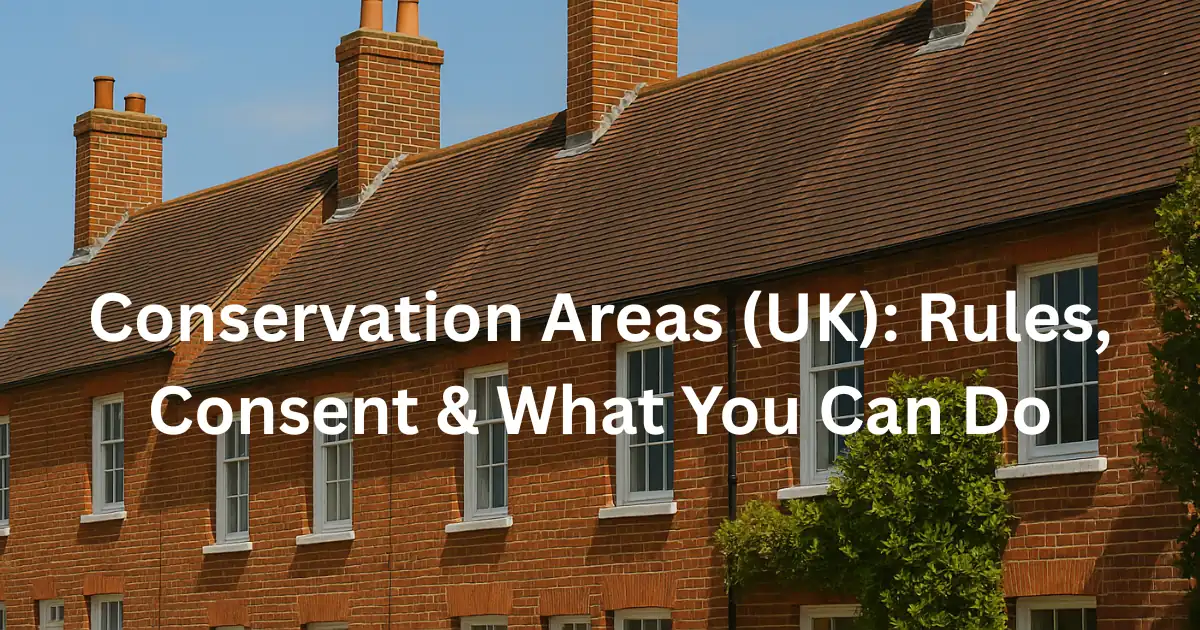Share this post:
Thinking about work in a Conservation Area?
We’ll check if you need Conservation Area Consent or full planning permission before you start.
If you live in or near a Conservation Area, you’ll need to follow extra planning rules. This guide explains what Conservation Areas are, what you can and can’t do, when consent is required, and how local council quirks can affect your project.
Summary: Conservation Areas are designated by local councils to protect historic or special character. Extra planning restrictions apply, and in many cases you’ll need Conservation Area Consent in addition to normal planning permission. This guide covers the key rules, costs, and local quirks you need to know before starting work.
What is a Conservation Area?
A Conservation Area is a zone designated by a local authority for its special architectural or historic interest. These areas protect the character of towns, villages, and neighbourhoods from inappropriate development. In England, over 10,000 Conservation Areas have been identified, ranging from city centres to rural hamlets.
Rules & Restrictions
Compared to standard planning rules, Conservation Areas place tighter controls on development. Some examples include:
- Demolition of buildings often requires permission, even for smaller structures.
- Restrictions on altering roofs, chimneys, and cladding.
- Stricter rules for replacement windows, doors, and external materials.
- Trees are protected — even pruning may need council consent.
When is Conservation Area Consent Required?
Conservation Area Consent is needed for:
- Demolishing any building or part of a building.
- Altering the external appearance of a property where the character may be affected.
- Cutting down or significantly pruning trees.
Some small projects may fall under Permitted Development Rights, but these rights are often restricted in Conservation Areas.
Not sure if your idea fits Conservation Area rules?
We’ll review your project and let you know if it qualifies under PD or needs a full application.
Common Projects in Conservation Areas
Windows & Doors
Replacing uPVC windows may not be allowed; timber sash or like-for-like styles are usually required.
Extensions & Conversions
Kitchen extensions, loft conversions, and garage conversions may need full planning permission, even if they’d normally fall under PD elsewhere.
See our guides:
Outbuildings & Sheds
Garden rooms and sheds are often restricted in terms of size, height, and position. See our guide: Planning Permission for a Shed.
Council Quirks & Local Variations
Every council applies rules slightly differently. For example:
- Some councils insist on timber windows only, others allow slimline aluminium.
- Tree works may require six weeks’ notice even for light pruning.
- Boundary walls and railings are often protected.
Costs & Timelines
There is no extra fee for Conservation Area Consent itself, but you’ll pay the standard planning application fees if a full application is required. Timelines are usually:
- 8 weeks — standard decision period for householder applications.
- Longer if applications require design revisions or committee approval.
FAQs: Conservation Areas
What does Conservation Area mean?
An area designated by the council for its special architectural or historic interest, where extra planning rules apply.
What can you not do in a Conservation Area?
You can’t demolish buildings, remove trees, or replace windows/doors without consent. Councils tightly control materials and designs.
Is Conservation Area Consent different from Planning Permission?
Yes — consent relates specifically to demolition or alterations affecting character. You may need both consent and full planning permission.
Does Conservation Area Consent still exist?
Yes, although in many cases it is now part of the wider planning application process. Always confirm with your local council.
Who is responsible for Conservation Areas?
Local councils designate and enforce Conservation Areas. National guidance is available via the Planning Portal.
Ready to move your project forward?
Plans Made Easy can prepare compliant plans, manage submissions, and guide you from idea to approval.
Next Steps & Useful Guides

Performance Verified ✅
This page meets PME Optimisation Standards — achieving 95+ Desktop and 85+ Mobile PageSpeed benchmarks. Verified on


